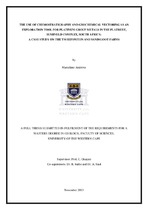| dc.description.abstract | The Platreef is known for its complexity and its heterogeneous lithologies, coupled with an unpredictable PGE and BMS mineralisation. The motivation behind this study was to aid mining geologists in targeting mineralisation irrespective of the farm. It is known that the Platreef generally overlies different footwall lithologies at individual farms. Thus, the aims of this study were firstly to investigate the potential of chemostratigraphy by delineating indices indicative of distinctive lithological layers. These indices were then tied to the second aim; which were to use geochemical vectoring, which is process-based, to target the PGEs at two
different farms. This study included three drillcores: from the farms Sandsloot (SS339) and Tweefontein (TN754 and TN200). The footwall units at Tweefontein are shales of the Duitschland Formation and the Penge banded iron formation; and at Sandsloot it is the Malmani Subgroup dolomites. Samples included 121 quarter cores, used for petrographical and geochemical studies. The elemental rock composition was determined by XRF and ICP-OES analyses. The approach also included statistical and mass balance methods to understand the geological and
geochemical controlling processes. Initially, the Platreef package at both farms was petrographically divided into three main layers: pyroxenite, and two distinctive feldspathic pyroxenites (FP-I and FP-II). However, the pyroxenites were also further separated as P-I and P-II, because of a higher notable difference in the degree of alteration within P-I. Progressive degrees of metasomatism were further
observed in the lithologies, e.g. within the Platreef package, where feldspathisation was potentially the main metasomatic process. Many geochemical plots (corroborated by the petrographical and mass balance results) illustrated that the feldspathisation were linked to an increase in the content of Al₂O₃ and CaO, and coupled with a decrease in content of Fe₂O₃ and MgO. Together with other
geochemical trends, geochemically distinct units of the Platreef package could be
discriminated with a metasomatism index (MI; CaO + 10Na₂O / CaO + 10Na₂O + Fe₂O₃ + MgO). The ensuing MI is lowest for the P-II pyroxenite and shows a progressive increase through FP-I, P-I to the highest values in FP-II. Geochemical layering were also observed in the calcsilicates and hornfels; e.g. a progressive decrease in the content of Fe₂O₃, Al₂O₃, Ce, Co, Cu, Ni, Zn, Zr, Au, Pd and Pt from the hornfels subunits H-I, H-II to H-III and an increase in of SiO₂, Fe₂O₃, TiO₂, SO₃, Co, Cu, Ni, Rb, V and Zn content from CS-I, CS-II to CS-III. Correlating the pyroxenites and feldspathic pyroxenites spatially from one drillcore to another were hindered, hence, chemostratigraphy were not completed. In terms of vectoring, it was essential to establish a possible link between the metasomatism
index and the nature and style of the PGE and/or BMS mineralisation. The Hornfels subunit H-I and calcsilicate subunit CS-III were the main carriers of BMS and PGE. The Platreef package were more complicated: P-I (low PGE, low BMS); P-II (low PGE, high BMS); FP-II (high PGE, low BMS); and FP-I (high PGE, high BMS). Element indices (e.g. Cu+Ni and Co+Zn) were developed to define a consistent gradient indicative of these ore subunits. A validation process to assess the metasomatism index (MI), base metal indices and PGE distribution within the individual drillcores (TN754, TN200 and SS339) were then undertaken. The results were that the MI ranges were similar in all drillcores, and discriminated the subunits of the Platreef package, gabbronorites and even the calcsilicates. The base metal ratios (e.g. Ni/Co and Cu/Co) were indicative of the PGE rich zones. Trends of the base metal ratios reflected a strong positive relationship with the MI
within the Platreef package and the calcsilicates. However, the opposite trend is observed with the hornfels. In conclusion, the MI could potentially be a strong vector of high PGE and BMS mineralisation. It is also possible to discriminate lithologies within the Platreef package with the MI. However, it should be noted that the limitation of this study is that the results are based on three drillcores. The Platreef is heterogeneous at individual farms and extremely diverse across the northern limb. Therefore, future research could be undertaken to validate these findings, by using a bigger drillcore database. | en_US |

